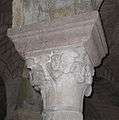Rotonda di San Tomè, Almenno San Bartolomeo


The Rotonda di San Tomè (Italian: Rotunda of St. Thomas) is a church in the comune of Almenno San Bartolomeo, in the province of Bergamo, Lombardy, Northern Italy.
The church has a circular plan and is in the Lombard-Romanesque style, dating from the early 12th century, and dedicated to St. Thomas the Apostle.
History
The church was built in the district known in ancient times as Lemine. The date of its construction is uncertain, as well as the existence of other churches on the same site, as it is known a reconstruction was carried on between the end of the 11th and the beginning of the 12th century. It has been speculated it could have been originated in Lombard times (7th-8th centuries), while other scholars assign it to the subsequent Frankish conquest of northern Italy, when the area was under the counts of Lecco.
It has been hypothesised that the Rotonda was built over the remains of a Roman temple, but archaeological investigations have found no sign of this. They have shown that a centrally planned edifice was present here in the 10th century.
This edifice had decayed in such a way that in the early 12th century the bishop of Bergamo decided on its complete reconstruction. Only the foundations and the columns and capitals of the former building were re-used for the ground floor. The columns were extended with reversed capitals at the base or by adding pieces of other columns. Around the end of the 12th century a presbytery and an apse were also built. In the meantime a monastery was added to the church, with nuns coming especially from the wealthy class of Bergamo. This monastery was suppressed in 1407; only the foundations and minor parts of the buildings can be seen today.
Architecture
One of the most notable examples of Romanesque architecture in northern Italy, the Rotonda di San Tomè has a central plan with a pyramidal composition, with three cylindrical volumes put one above the other. The second volume constitutes the matronaeum, a women's gallery, and has flat pilasters on its wall. The third volume is the lantern, with four elegant mullioned windows.
To the rear of the Rotonda are the rectangular presbytery and semi-circular apse. The whole structure is lit by slit windows and small arched windows.
The interior has eight columns in a circle creating two concentric spaces. The wall enclosing them has niches marked by semi-columns with elegant capitals. Traces of frescoes can still be seen.
The upper matronaeum has also eight columns which creates a circular ambulatory facing the central hollow of the lower section. It has also a small apse with traces of frescoes. The capitals on both floors, and the portal, have well sculpted zoomorphic, human and geometric figures
Gallery
-
Exterior view of the apse and the presbytery.
-
Detail of one of the sculpted capitals of the portal.
-

Detail of a capital.
-
Detail of the apse.
References
- Nodari, R.; P. Manzoni (1997). La rotonda di San Tomè. Sondrio: Lyasis. ISBN 88-86711-18-2.
Coordinates: 45°44′23.4″N 9°35′34″E / 45.739833°N 9.59278°E